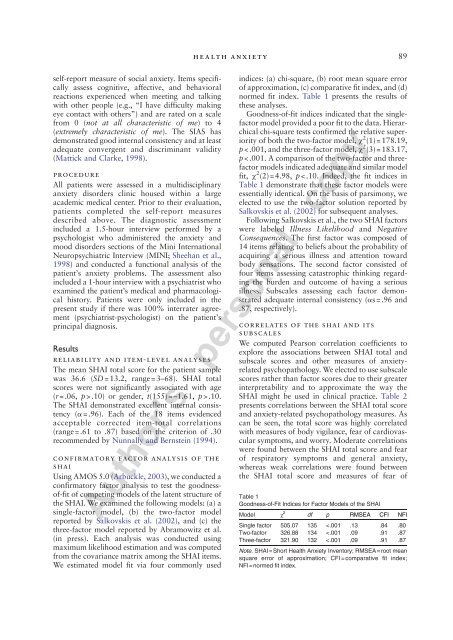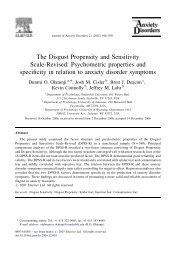88 abramowitz et al.Therefore, we specifically examined how well <strong>the</strong>SHAI distinguishes HC patients from those withPD.MethodparticipantsParticipants were 157 adults (i.e., ≥18 years old)with a primary (principal) diagnosis <strong>of</strong> HC or ananxiety disorder (diagnostic and assessment proceduresare described below) who were seekingevaluation and treatment. Forty-nine patients hada principal diagnosis <strong>of</strong> PD, followed by 32 withsocial phobia, 21 with GAD, 18 with OCD, and 16with specific phobia. Twenty-one patients had HC.Many had additional Axis I diagnoses (42.0%),including 26 (16.64%) with depressive disorders.The mean age <strong>of</strong> <strong>the</strong> sample was 36.4 (SD=13.5)and about half <strong>of</strong> <strong>the</strong> patients were women (n=93,59.2%). The sample was predominantely Caucasian(n=138, 87.9%). Nearly all participants hadearned a high school diploma (97.4%), and overhalf (52%) held at least a 2-year college degree.About half <strong>the</strong> sample was married (55.4%), and<strong>the</strong> median family income was between $50,000and $60,000 per year.measuresShort <strong>Health</strong> <strong>Anxiety</strong> <strong>Inventory</strong> (SHAI; Salkovskiset al., 2002). The SHAI is a self-report measurethat contains 18 items assessing health anxietyindependently <strong>of</strong> physical health status. Itemsmeasure worry about health, awareness <strong>of</strong> bodilysensations or changes, and feared consequences <strong>of</strong>having an illness using a multiple-choice format.Salkovskis et al. (2002) identified two factorscorresponding to (a) <strong>the</strong> feared likelihood <strong>of</strong>becoming ill, and (b) <strong>the</strong> feared negative consequences<strong>of</strong> becoming ill. The SHAI has demonstratedgood reliability and validity in clinical andnonclinical samples (Abramowitz, Deacon, &Valentiner, in press; Salkovskis et al., 2002).Body Vigilance Scale (BVS; Schmidt et al.,1997). The 4-item self-report BVS measures <strong>the</strong>tendency to attend to anxiety-related body sensations.Items assess (a) <strong>the</strong> degree <strong>of</strong> attentional focus,(b) perceived sensitivity to changes in bodilysensations, and (c) time spent attending to bodilysensations on 10-point scales. The fourth iteminvolves separate ratings for attention to 15different anxiety-related sensations (e.g., heartpalpitations, dizziness). The BVS has good internalconsistency and adequate test-retest reliability(Schmidt et al., 1997).<strong>Anxiety</strong> Sensitivity Index–Revised (ASI-R; Taylor& Cox, 1998). The ASI-R is a 36-item, expandedversion <strong>of</strong> <strong>the</strong> original ASI (Reiss, Peterson,Gursky, & McNally, 1986) and measures <strong>the</strong>fear <strong>of</strong> anxiety-related sensations based on beliefsabout <strong>the</strong>ir harmful consequences. Respondentsindicate <strong>the</strong>ir agreement with each item on a scaleranging from “very little” (coded as 0) to “verymuch” (coded as 4). Total scores range from 0 to144. The ASI-R has demonstrated excellent internalconsistency and adequate validity (Deacon,Abramowitz, Woods, & Tolin, 2003; Taylor &Cox, 1998). Prior factor analytic research on <strong>the</strong>ASI-R has revealed lower-order dimensions pertainingto fear <strong>of</strong> respiratory, publicly observableanxiety reactions, cardiovascular, and cognitivedyscontrol that may have implications for differentdisorders relative to <strong>the</strong> total score (Deacon et al.,2003). Thus, we elected to calculate subscalescores consistent with <strong>the</strong> four ASI-R factorsra<strong>the</strong>r than <strong>the</strong> ASI-R total score.Penn State Worry Questionnaire (PSWQ; Meyer,Miller, Metzger, & Borkovec, 1990). The PSWQ isa 16-item self-report inventory designed to capture<strong>the</strong> generality, excessiveness, and uncontrollabilitydimensions <strong>of</strong> pathological worry without regard toits specific content. Each item is rated on a 1 (not atall typical <strong>of</strong> me) to5(very typical <strong>of</strong> me) Likerttypescale (e.g., “My worries overwhelm me”). ThePSWQ possesses good internal consistency and testretestreliability in clinical samples and is at leastmoderately correlated with o<strong>the</strong>r measures <strong>of</strong> traitworry (Molina & Borkovec, 1994).Obsessive-Compulsive <strong>Inventory</strong>–Revised (OCI-R;Foa et al., 2002). The OCI-R is an 18-item selfreportquestionnaire based on <strong>the</strong> earlier 84-itemObsessive-Compulsive <strong>Inventory</strong> (Foa, Kozak, Salkovskis,Coles, & Amir, 1998). Respondents rate<strong>the</strong> degree to which <strong>the</strong>y have been bo<strong>the</strong>red ordistressed by 18 common symptoms <strong>of</strong> OCD in <strong>the</strong>past month. The OCI-R assesses six symptomdomains: (a) washing, (b) checking/doubting, (c)obsessing, (d) mental neutralizing, (e) ordering, and(f) hoarding. OCI-R total scores have demonstratedexcellent psychometric properties and validity (Foaet al., 2002).Beck <strong>Anxiety</strong> <strong>Inventory</strong> (BAI; Beck, Epstein,Brown, & Steer, 1988). The BAI is a self-reportinstrument that assesses 21 common symptoms <strong>of</strong>clinical anxiety (e.g., sweating, fear <strong>of</strong> losingcontrol). Respondents indicate <strong>the</strong> degree towhich <strong>the</strong>y have recently been bo<strong>the</strong>red by eachsymptom during <strong>the</strong> past week. The BAI wasdesigned to assess anxiety symptoms independentlyfrom depression symptoms and has good reliabilityand validity (Beck et al., 1988).Social Interaction <strong>Anxiety</strong> Scale (SIAS; Mattick& Clarke, 1998). The SIAS is a widely used 20-itemAuthor's personal copy
health anxiety89self-report measure <strong>of</strong> social anxiety. Items specificallyassess cognitive, affective, and behavioralreactions experienced when meeting and talkingwith o<strong>the</strong>r people (e.g., “I have difficulty makingeye contact with o<strong>the</strong>rs”) and are rated on a scalefrom 0 (not at all characteristic <strong>of</strong> me) to 4(extremely characteristic <strong>of</strong> me). The SIAS hasdemonstrated good internal consistency and at leastadequate convergent and discriminant validity(Mattick and Clarke, 1998).procedureAll patients were assessed in a multidisciplinaryanxiety disorders clinic housed within a largeacademic medical center. Prior to <strong>the</strong>ir evaluation,patients completed <strong>the</strong> self-report measuresdescribed above. The diagnostic assessmentincluded a 1.5-hour interview performed by apsychologist who administered <strong>the</strong> anxiety andmood disorders sections <strong>of</strong> <strong>the</strong> Mini InternationalNeuropsychiatric Interview (MINI; Sheehan et al.,1998) and conducted a functional analysis <strong>of</strong> <strong>the</strong>patient’s anxiety problems. The assessment alsoincluded a 1-hour interview with a psychiatrist whoexamined <strong>the</strong> patient’s medical and pharmacologicalhistory. Patients were only included in <strong>the</strong>present study if <strong>the</strong>re was 100% interrater agreement(psychiatrist-psychologist) on <strong>the</strong> patient’sprincipal diagnosis.Resultsreliability and item-level analysesThe mean SHAI total score for <strong>the</strong> patient samplewas 36.6 (SD=13.2, range=3–68). SHAI totalscores were not significantly associated with age(r=.06, p>.10) or gender, t(155)=–1.61, p>.10.The SHAI demonstrated excellent internal consistency(α=.96). Each <strong>of</strong> <strong>the</strong> 18 items evidencedacceptable corrected item-total correlations(range=.61 to .87) based on <strong>the</strong> criterion <strong>of</strong> .30recommended by Nunnally and Bernstein (1994).confirmatory factor analysis <strong>of</strong> <strong>the</strong>shaiUsing AMOS 5.0 (Arbuckle, 2003), we conducted aconfirmatory factor analysis to test <strong>the</strong> goodness<strong>of</strong>-fit<strong>of</strong> competing models <strong>of</strong> <strong>the</strong> latent structure <strong>of</strong><strong>the</strong> SHAI. We examined <strong>the</strong> following models: (a) asingle-factor model, (b) <strong>the</strong> two-factor modelreported by Salkovskis et al. (2002), and (c) <strong>the</strong>three-factor model reported by Abramowitz et al.(in press). Each analysis was conducted usingmaximum likelihood estimation and was computedfrom <strong>the</strong> covariance matrix among <strong>the</strong> SHAI items.We estimated model fit via four commonly usedindices: (a) chi-square, (b) root mean square error<strong>of</strong> approximation, (c) comparative fit index, and (d)normed fit index. Table 1 presents <strong>the</strong> results <strong>of</strong><strong>the</strong>se analyses.Goodness-<strong>of</strong>-fit indices indicated that <strong>the</strong> singlefactormodel provided a poor fit to <strong>the</strong> data. Hierarchicalchi-square tests confirmed <strong>the</strong> relative superiority<strong>of</strong> both <strong>the</strong> two-factor model, χ 2 (1)=178.19,p




